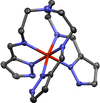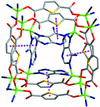issue contents
December 2015 issue

Cover illustration: A new route for the synthesis of phosphate esters with a retained six-membered ring produced 2,2'-[benzene-1,2-diylbis(oxy)]bis(5,5-dimethyl-1,3,2-dioxaphosphinane) 2,2'-dioxide in which two 1,3,2-dioxaphosphinane groups are linked through a catechol group. The conformations about the two catechol O atoms are quite different. See Said, Ali & Hughes [Acta Cryst. (2015), C71, 1037-1041].
research papers


































 journal menu
journal menu

































